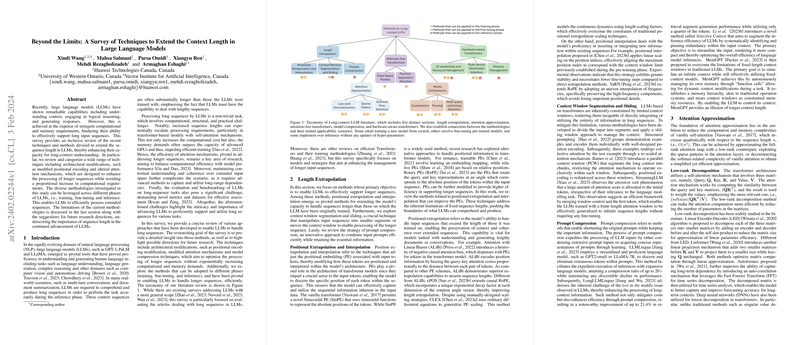Extending Context Length in LLMs: A Comprehensive Survey
Overview of Techniques
The increasing demands of real-world applications for processing long sequences necessitate innovative approaches to extend the context length handled by LLMs. This survey categorizes and reviews recent advancements in techniques aimed at empowering LLMs with an enhanced capacity for long-context understanding. The focus is on architectural modifications, training and inference optimization strategies, and hardware-conscious solutions that enable efficient management of extended sequences.
Key Techniques Explored
Positional Extrapolation and Interpolation
Positional encoding extensions play a pivotal role in enhancing LLM's comprehension of longer sequences. Innovations like ALiBi and xPOS showcase strategies to modify positional embedding, enabling LLMs to extrapolate beyond the sequence lengths encountered during training. Attention to detail in adaptive scaling and optimization ensures that the LLMs maintain performance stability across varied lengths, addressing inherent scalability issues.
Context Window Manipulation
Strategies such as structured prompting and parallel context window segmentation directly tackle the limitations posed by fixed context windows. Techniques like StreamingLLM, which leverages the attention sink phenomenon, underscore an efficiency-driven approach to adapting LLMs for infinite sequences without necessitating reparameterization or extensive fine-tuning.
Prompt Compression
Prompt compression methods, notably LLMLingua and its successor LongLLMLingua, provide a fascinating insight into condensing inputs while preserving crucial information. These methods offer a dual advantage of reducing computational load and enhancing LLMs' focus on relevant data within longer sequences.
Attention Approximation
Exploring low-rank decomposition and sparse patterns amidst attention mechanisms illuminates a pathway towards reducing quadratic computation complexities. Methods like Linformer and Longformer embody this by introducing efficient approximation and sparsity, ensuring scalable performance without compromising attention quality significantly.
Attention-free Transformation
Delving into state-space models and position-dependent attention, we uncover alternatives to traditional attention mechanisms. These attention-free paradigms, illustrated by the State Space Model (SSM) and Attention-Free Transformer (AFT), introduce a radical shift towards linear complexity, offering scalable and efficient solutions without relying on conventional attention-based interactions.
Model Compression
Quantization and pruning emerge as impactful strategies for model size reduction, facilitating longer sequence processing. Through fine-grained control over precision and structural pruning, methods like LLM-QAT and SparseGPT not only reduce computational overhead but also pave the way for intricate sequence management without substantial loss in model fidelity.
Practical Implications and Hardware Considerations
The survey further traverses the field of hardware-aware transformers, emphasizing IO-awareness, resource management, and multi-device distributed attention techniques. Innovations like FlashAttention and Ring Attention demonstrate how adapting to hardware constraints can significantly boost LLMs' efficiency in managing long sequences. These hardware-conscious strategies enable the leveraging of advanced computational platforms, enhancing the scalability and adaptability of LLMs to accommodate increasingly complex tasks.
Future Directions
While considerable progress has been made, the trajectory of research into extending LLMs' context length hints at several prospective directions. Future endeavors could focus on further optimizing LLM architectures for efficiency, exploring sophisticated attention mechanisms or incorporating external knowledge bases to enrich context understanding. Innovations in training methodologies, emphasizing gradual exposure to longer sequences, may also hold the key to unlocking new potentials in LLM capabilities. Moreover, establishing comprehensive benchmarking frameworks would critically support the assessment of LLMs' long-sequence processing efficacy, guiding the evolution of more capable and versatile models.
This survey not only encapsulates the expanse of current methodologies aimed at enhancing LLMs' proficiency with long sequences but also underscores the imperative for continued innovation. As we stride forward, the interplay between architectural ingenuity, hardware optimization, and novel training paradigms will undoubtedly shape the next wave of advancements in the field of natural language processing.
